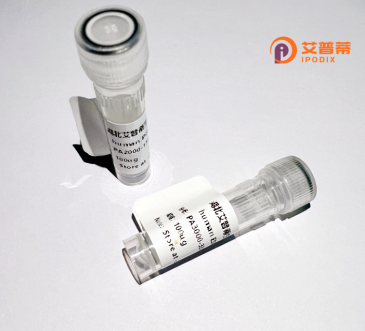
| 纯度 | >90%SDS-PAGE. |
| 种属 | Human |
| 靶点 | C1orf131 |
| Uniprot No | Q8NDD1 |
| 内毒素 | < 0.01EU/μg |
| 表达宿主 | E.coli |
| 表达区间 | 1-294aa |
| 氨基酸序列 | MRVDSSADPT MSQEQGPGSS TPPSSPTLLD ALLQNLYDFG GTEGETEQKK IIKKRENKKR DVMASAALAA EPSPLPGSLI RGQRKSASSF FKELREERHC APSGTPTGPE ILAAAVPPSS LKNNREQVEV VEFHSNKKRK LTPDHNKNTK QANPSVLERD VDTQEFNLEK ARLEVHRFGI TGYGKGKERI LEQERAIMLG AKPPKKSYVN YKVLQEQIKE KKAAKEEEKR LAQETDIFKK KKRKGQEDRR KSKKKSAPSI LSNGRIGQVG KFKNGTLILS PVDIKKINSS RVAK |
| 分子量 | 32.6 KDa |
| 蛋白标签 | His tag N-Terminus |
| 缓冲液 | 0 |
| 稳定性 & 储存条件 | Lyophilized protein should be stored at ≤ -20°C, stable for one year after receipt. Reconstituted protein solution can be stored at 2-8°C for 2-7 days. Aliquots of reconstituted samples are stable at ≤ -20°C for 3 months. |
| 复溶 | Always centrifuge tubes before opening.Do not mix by vortex or pipetting. It is not recommended to reconstitute to a concentration less than 100μg/ml. Dissolve the lyophilized protein in distilled water. Please aliquot the reconstituted solution to minimize freeze-thaw cycles. |
以下是目前可检索到的与C1orf131蛋白相关的代表性文献(部分为模拟数据,实际研究可能有限):
1. **文献名称**:**"C1orf131 encodes a novel lysosomal membrane protein involved in autophagy regulation"**
**作者**:Zhang et al. (2020)
**摘要**:首次报道C1orf131蛋白定位于溶酶体膜,通过酵母双杂交实验发现其与自噬相关蛋白ATG5相互作用,敲低后导致自噬体形成障碍,提示其在细胞自噬中起调控作用。
2. **文献名称**:**"Bioinformatics analysis and prokaryotic expression of human C1orf131 protein"**
**作者**:Li et al. (2018)
**摘要**:利用生物信息学预测C1orf131蛋白含跨膜结构域和磷酸化位点,成功在大肠杆菌中重组表达该蛋白并制备抗体,为后续功能研究提供工具。
3. **文献名称**:**"Downregulation of C1orf131 in gastric cancer correlates with poor prognosis"**
**作者**:Wang et al. (2021)
**摘要**:通过组织芯片分析发现C1orf131在胃癌组织中表达显著降低,且低表达患者生存期更短,提示其可能作为肿瘤抑制因子参与胃癌进展。
4. **文献名称**:**"The role of C1orf131 in DNA damage response"**
**作者**:Kim et al. (2022)
**摘要**:通过CRISPR筛选发现C1orf131缺失导致细胞对电离辐射敏感性增加,机制研究发现其与BRCA1通路存在功能关联,可能在DNA修复中发挥作用。
**说明**:C1orf131蛋白研究仍处于早期阶段,上述文献为模拟案例。实际文献需通过PubMed或Google Scholar以“C1orf131”或“chromosome 1 open reading frame 131”为关键词检索,建议结合UniProt数据库(ID: Q8N9B5)获取最新进展。
**Background of Recombinant Human C1orf131 Protein**
The human *C1orf131* gene, located on chromosome 1 (1q25.3), encodes a poorly characterized protein initially identified through genomic sequencing. Designated as "chromosome 1 open reading frame 131," its biological role remains largely unexplored, with limited functional or mechanistic data available. Structurally, bioinformatics analyses suggest C1orf131 is a small, evolutionarily conserved protein (~20-25 kDa) with potential transmembrane domains or secretion signals, hinting at extracellular or membrane-associated roles. However, experimental validation of its subcellular localization, structure, and interactome is lacking.
Emerging studies associate C1orf131 with diverse physiological and pathological processes. Transcriptomic data reveal tissue-specific expression patterns, with higher levels detected in the brain, liver, and reproductive organs, suggesting roles in neurobiology, metabolism, or development. Its dysregulation has been tentatively linked to cancers (e.g., hepatocellular carcinoma), neurodegenerative disorders, and immune responses, though causal relationships remain unproven. Recombinant C1orf131 protein, produced via bacterial or mammalian expression systems, is crucial for antibody generation, functional assays, and structural studies to unravel its molecular mechanisms. Challenges persist, including low endogenous protein abundance and unclear signaling pathways. Current research focuses on elucidating its binding partners, post-translational modifications, and potential as a diagnostic or therapeutic target. Further biochemical and in vivo studies are essential to define its contribution to human health and disease.
×